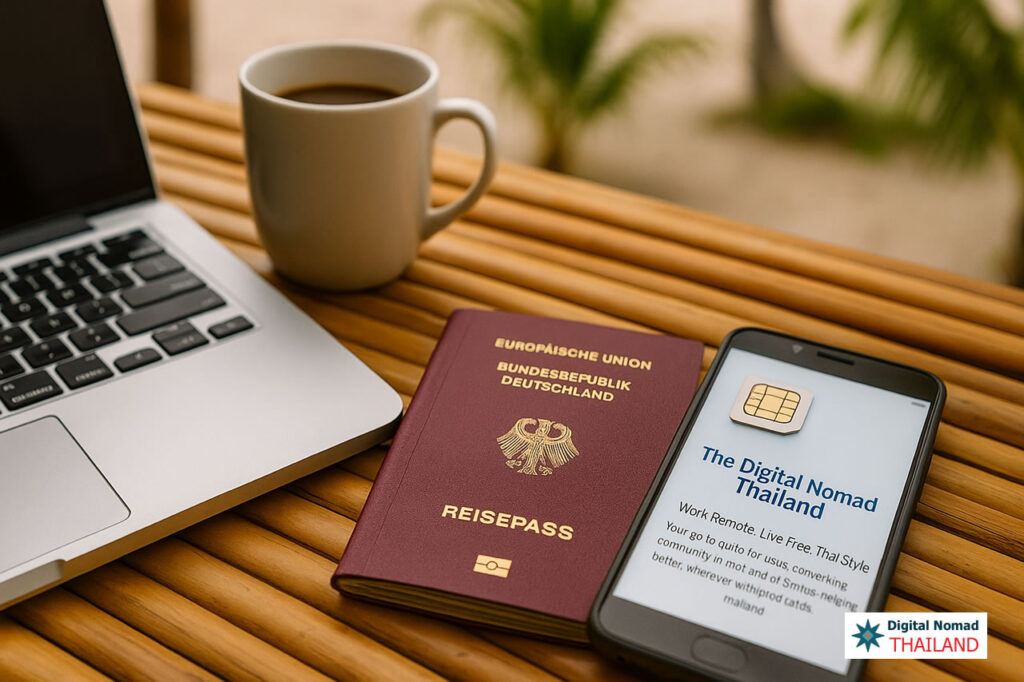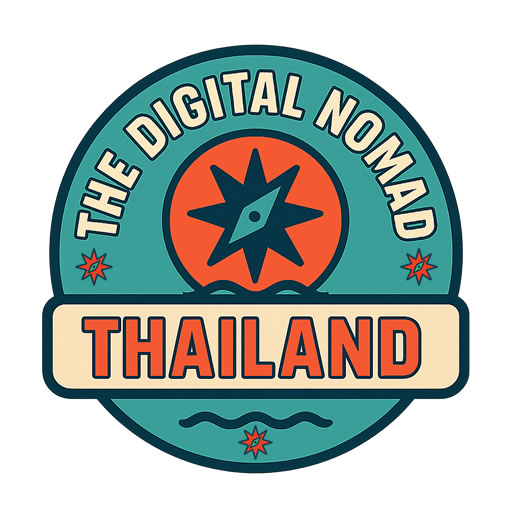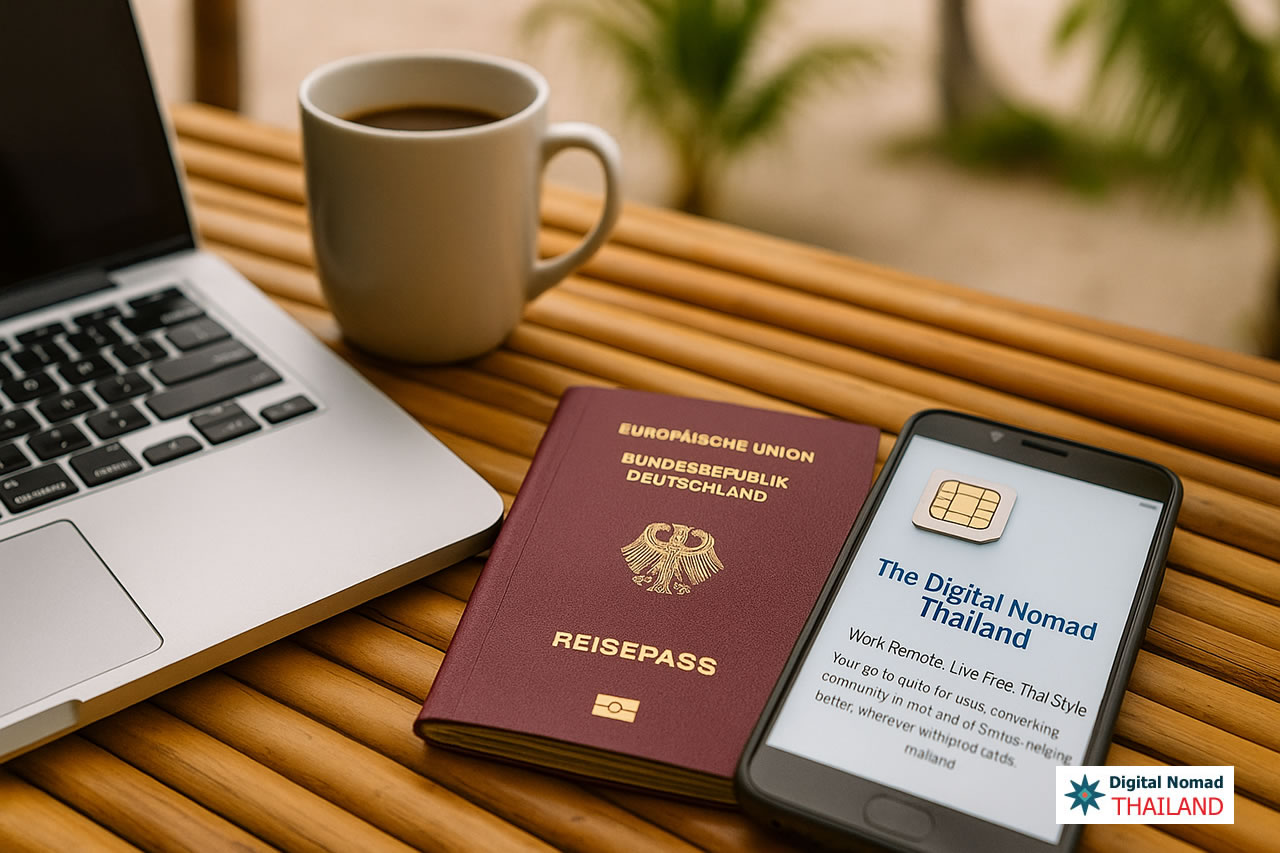
Thailand is a sweet spot for digital nomads: fast networks, wide coverage, and data plans that don’t blow your budget. The tricky bit is choosing the right option when you’ve just landed and every kiosk promises “unlimited.”
📌 Sorting out your SIM is step one — right alongside what you pack. Check out my Digital Nomad Packing List for Thailand to make sure you arrive ready.
This quick guide cuts the noise for 2025. We’ll compare AIS, TrueMove H, and DTAC; show when eSIMs make sense; and outline the best picks for short trips, month-to-month stays, and longer runs—plus where to buy and what you should actually pay.
Why Mobile Data Matters for Digital Nomads
When you’re working remotely, a solid internet connection is as important as your laptop. Thailand has great Wi-Fi in cafés, hotels, and co-working spaces, but relying on it alone can be risky. Power cuts, overloaded networks, or being stuck on a long bus ride can throw your workday off.
That’s where a local SIM card comes in. With 4G and 5G coverage across most of the country, having mobile data means you can tether your laptop, join video calls on the move, and stay connected whether you’re in Bangkok, Chiang Mai, or even on an island beach.
Main Mobile Providers in Thailand
Thailand has three major mobile networks, and as a digital nomad you’ll end up with one of them. The good news is all three offer prepaid and postpaid plans, and competition keeps prices low.
- AIS – Known for the best nationwide coverage, especially outside big cities. If you plan to spend time on islands or in rural areas, AIS is usually the most reliable.
- TrueMove H – Often praised for fast speeds and strong 5G service in urban centers. If you’re mainly in Bangkok, Chiang Mai, or Phuket, True can feel lightning quick.
- DTAC – The budget-friendly option. Coverage is improving but can still lag behind in remote areas. Good if you’re staying in major towns and want to save a bit.
📌 Most nomads find AIS or TrueMove the safest bets, while DTAC works if your travels keep you near cities.
| Provider | Coverage | Speed | Typical Price |
|---|---|---|---|
| AIS | Best nationwide, strong in rural areas & islands | Reliable 4G/5G | 300–600 THB/month |
| TrueMove H | Excellent in cities, good 5G coverage | Fastest speeds in urban areas | 300–650 THB/month |
| DTAC | Decent in cities, weaker in rural areas | Good in towns, less consistent elsewhere | 250–500 THB/month |
Best SIM Options for Digital Nomads (2025)
Not every digital nomad stays in Thailand the same way. Some drop in for a few weeks, others base themselves here for half a year, and a few settle in long-term. The best SIM choice depends on how long you’ll be around:
- Short-term travelers (under 1 month):
Tourist SIMs are the easiest option. You’ll find them at airport counters and 7-Elevens, usually bundled with big data packages and some free calls. They’re more expensive than local plans, but the convenience makes sense if you’re only here briefly.
- Mid-term nomads (1–6 months):
Prepaid monthly packages from AIS, True, or DTAC are the sweet spot. For 300–600 THB, you’ll get 30 days of unlimited data with fair usage caps. You can top up online or at any convenience store.
- Longer stays (6+ months):
A postpaid plan can save hassle. These require a passport, and sometimes a long-stay visa or work permit, but you’ll get stable billing and often better value over time.
- eSIMs:
If your phone supports them, eSIMs like Airalo or Nomad let you skip the plastic card altogether. They’re ideal if you’re bouncing between countries, though local SIMs usually give more data for the money.
Where to Buy a SIM Card in Thailand
Getting a SIM in Thailand is simple, and you’ve got several options depending on how quickly you need to get connected:
- Airports – Kiosks from AIS, True, and DTAC are in all major airports. You’ll pay a bit more, but you’ll be online before you even leave the terminal.
- Convenience stores (7-Eleven / Family Mart) – You can pick up prepaid SIMs almost anywhere. Staff will register it with your passport and get you set up in minutes.
- Official provider shops – Best if you’re signing up for a postpaid plan or need help switching packages. You’ll find AIS, True, and DTAC shops in every city and most malls.
📌 Remember: you’ll need your passport to buy and activate any SIM card in Thailand. If you’re new here, it’s also worth learning how payments and top-ups work. My guide on Banking & Financial Tips for Expats in Thailand covers ATMs, online payments, and how to manage money smoothly while abroad.
Tips for Digital Nomads Choosing a SIM
- Bring your passport – It’s required for registration. No passport, no SIM.
- Check tourist vs. local plans – Tourist SIMs are quick but often pricier. If you’re here more than a couple of weeks, switch to a local prepaid plan.
- Look at your travel route – If you’ll spend time on islands or rural areas, AIS is usually the safest choice.
- Keep it flexible – Prepaid plans let you change providers or upgrade if you’re not happy.
- Hotspot ready – Make sure your plan allows tethering so you can use your laptop anywhere.
- eSIM convenience – Great for short stays or frequent border runs, but expect to pay a little extra.
Related Costs
Thailand’s mobile data is among the cheapest in the world, and that’s a big win for digital nomads. Here’s what you can expect to spend:
- Prepaid monthly plans: around 300–600 THB for unlimited data (with fair usage caps).
- Tourist SIMs: typically 400–800 THB for 15–30 days, with big data bundles.
- Postpaid contracts: similar prices to prepaid, but billed automatically each month.
- eSIMs: usually 10–30% more expensive than local SIMs, depending on provider.
📌 Most nomads spend less than 20 USD per month on mobile data — a small line in the budget compared to housing, food, or co-working.
Thailand makes staying connected easy — with fast speeds, wide coverage, and some of the cheapest mobile data in the world. AIS is the best all-rounder, TrueMove H shines in the cities, and DTAC works well if you’re mostly in town and want to save a little.
For most digital nomads, a prepaid monthly plan is all you’ll need — flexible, affordable, and available everywhere from airports to 7-Eleven.
✅ Want the bigger picture of life in Thailand? Check out my main site Thrive in Thailand for complete expat guides on visas, healthcare, cost of living, and more.

